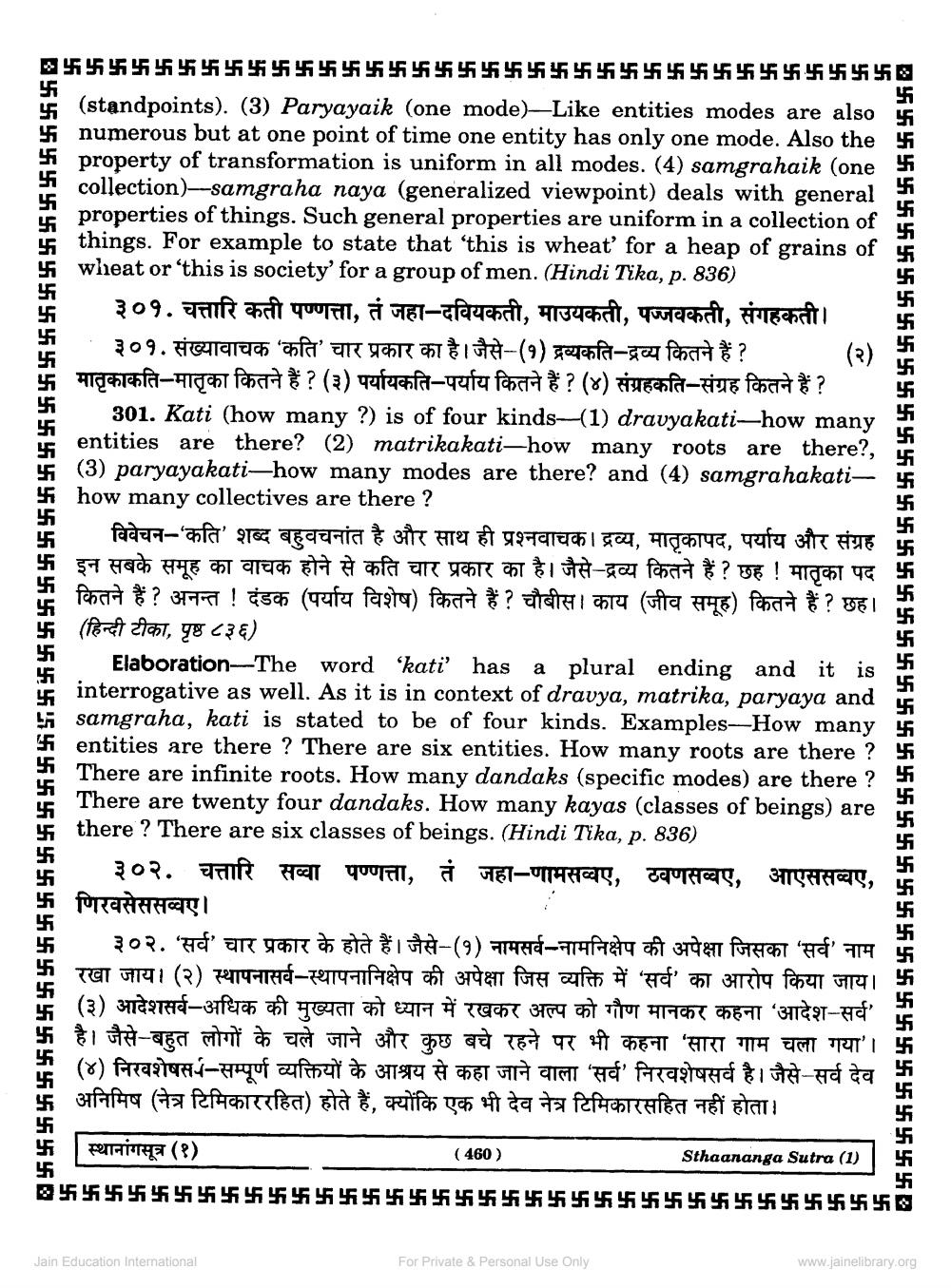________________
(standpoints). (3) Paryayaik (one mode)-Like entities modes are also numerous but at one point of time one entity has only one mode. Also the property of transformation is uniform in all modes. (4) samgrahaik (one collection)--samgraha naya (generalized viewpoint) deals with general properties of things. Such general properties are uniform in a collection of things. For example to state that 'this is wheat for a heap of grains of wheat or 'this is society' for a group of men. (Hindi Tika, p. 836)
३०१. चत्तारि कती पण्णत्ता, तं जहा-दवियकती, माउयकती, पज्जवकती, संगहकती। - ३०१. संख्यावाचक 'कति' चार प्रकार का है। जैसे-(१) द्रव्यकति-द्रव्य कितने हैं ? (२) मातृकाकति-मातृका कितने हैं ? (३) पर्यायकति-पर्याय कितने हैं ? (४) संग्रहकति-संग्रह कितने हैं ?
301. Kati (how many ?) is of four kinds(1) dravyakati—how many entities are there? (2) matrikakati-how many roots are there?,
(3) paryayakati-how many modes are there? and (4) samgrahakati$ how many collectives are there?
विवेचन-'कति' शब्द बहुवचनांत है और साथ ही प्रश्नवाचक। द्रव्य, मातृकापद, पर्याय और संग्रह 卐 इन सबके समूह का वाचक होने से कति चार प्रकार का है। जैसे-द्रव्य कितने हैं ? छह ! मातृका पद के कितने हैं ? अनन्त ! दंडक (पर्याय विशेष) कितने हैं ? चौबीस। काय (जीव समूह) कितने हैं ? छह। ॐ (हिन्दी टीका, पृष्ठ ८३६)
Elaboration-The word 'hati' has a plural ending and it is interrogative as well. As it is in context of dravya, matrika, paryaya and samgraha, kati is stated to be of four kinds. Examples-How many entities are there ? There are six entities. How many roots are there ? There are infinite roots. How many dandaks (specific modes) are there? There are twenty four dandaks. How many kayas (classes of beings) are there? There are six classes of beings. (Hindi Tika, p. 836)
३०२. चत्तारि सव्वा पण्णत्ता, तं जहा-णामसव्वए, ठवणसव्वए, आएससव्वए, मणिरवसेससब्बए।
३०२. 'सर्व' चार प्रकार के होते हैं। जैसे-(१) नामसर्व-नामनिक्षेप की अपेक्षा जिसका 'सर्व' नाम फ़ रखा जाय। (२) स्थापनासर्व-स्थापनानिक्षेप की अपेक्षा जिस व्यक्ति में 'सर्व' का आरोप किया जाय। - (३) आदेशसर्व-अधिक की मुख्यता को ध्यान में रखकर अल्प को गौण मानकर कहना 'आदेश-सर्व' ऊ है। जैसे-बहुत लोगों के चले जाने और कुछ बचे रहने पर भी कहना 'सारा गाम चला गया। + (४) निरवशेषस-सम्पूर्ण व्यक्तियों के आश्रय से कहा जाने वाला 'सर्व' निरवशेषसर्व है। जैसे-सर्व देव ॐ अनिमिष (नेत्र टिमिकाररहित) होते हैं, क्योंकि एक भी देव नेत्र टिमिकारसहित नहीं होता।
B55555555555555555555555555555555555555555555555558
| स्थानांगसूत्र (१)
(460)
Sthaananga Sutra (1)
854)
)
)
))
)
)
)
))
)
))
)
)
)
)
)
))
))
)
)))
Jain Education International
For Private & Personal Use Only
www.jainelibrary.org




